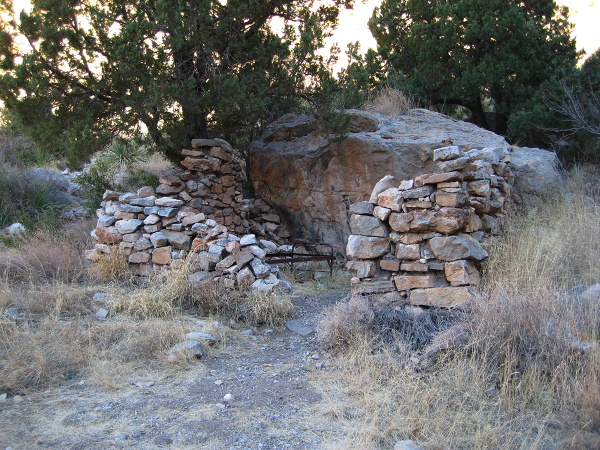Monday, February 11, 2008 - Pancho Villa State Park, Columbus NM
< previous day | archives | next day >

Line cabin, Dog Canyon Trail, Oliver Lee Memorial State Park, Alamogordo, New Mexico, February 2, 2008
The line cabin is built against a rock
What a clever idea. And what a great rock for the purpose. See how economically the builders of this little cabin set it right up against the flat side of that big rock? Most likely the work of building the cabin was done entirely by hand and those guys must have jumped at the chance to carry 25% fewer stones over here and fit them into place.
That rock probably has a moderating influence on the daily temperature extremes down here in this defile too. I don't know if that's helpful in the extreme summer heat but it should help keep the cabin warm during those cold winter nights after the sun goes down even though the sun doesn't reach this rock until late in the day during the winter months. If it reaches the rock at all in mid winter - it was mid day when I took this picture and as you can see the sun still hasn't quite reached the rock and I didn't stick around to see if the sun touched it later in the day.
Working on website
Today I started tweaking this website a bit to see if I can archive these Travels pages in a way that will make them easier to navigate. The Yesterday and Tomorrow links at the bottom of the pages are fine for linear reading but just don't cut it for finding older stuff. It wouldn't hurt if I managed to make some improvements to the whole site for that matter but I don't know if I can keep my attention trained on the project long enough to make a difference. We'll see.
Night camp
Site 29 - Pancho Villa State Park, Columbus NM
- Verizon cell phone service - good signal
- Verizon EVDO service - good signal
- Go to the Pancho Villa State Park website
- Locate Pancho Villa State Park on my Night Camps map
- Check the weather here
Teosinte and the Improbability of Maize
The ancestors of wheat, rice, millet, and barley look like their domesticated descendants; because they are both edible and highly productive, one can easily imagine how the idea of planting them for food came up. Maize can't reproduce itself, because its kernals are securely wrapped in the husk, so Indians must have developed it from some other species. But there are no wild species that resemble maize. Its closest genetic relative is a mountain grass called teosinte that looks strikingly different - for one thing, it "ears" are smaller than baby corn served in Chinese restaurants. No one eats teosinte, because it produces too little grain to be worth harvesting. In creating modern maize from this unpromising plant, Indians performed a feat so improbable that archaeologists and biologists have argued for decades over how it was achieved. Coupled with squash, beans, and avocados, maize provided Mesoamerica with a balanced diet, one arguably more nutritious than its Middle Eastern or Asian equivalent.